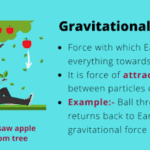During a free fall, the acceleration remains constant and is equal to the acceleration due to gravity (g), which is approximately 9.8 m/s² on Earth’s surface. This constant acceleration is directed downward towards the center of the Earth.
Explanation
To understand why acceleration remains constant during free fall, let’s break down the concept and explore the factors involved:
1. Definition of Free Fall
Free fall is a state of motion where an object is subjected only to the force of gravity, with no other forces acting upon it. In an ideal free fall scenario, we ignore air resistance and other external forces.
2. Newton’s Second Law of Motion
Newton’s Second Law states that the acceleration of an object is directly proportional to the net force acting on it and inversely proportional to its mass. Mathematically, this is expressed as:
$$ F = ma $$
Where:
- F is the net force
- m is the mass of the object
- a is the acceleration
3. Gravitational Force
The force of gravity acting on an object near Earth’s surface is given by:
$$ F_g = mg $$
Where:
- $F_g$ is the gravitational force
- m is the mass of the object
- g is the acceleration due to gravity (approximately 9.8 m/s² on Earth)
4. Combining Newton’s Second Law and Gravitational Force
Since the only force acting on an object in free fall is gravity, we can equate these two expressions:
$$ F = ma = mg $$
Canceling out the mass (m) on both sides, we get:
$$ a = g $$
This equation shows that the acceleration of an object in free fall is equal to the acceleration due to gravity, regardless of the object’s mass.
5. Constant Acceleration
The acceleration due to gravity (g) is essentially constant near Earth’s surface. It does vary slightly with altitude and geographical location, but these variations are negligible for most practical purposes in everyday scenarios.
6. Velocity and Position
While acceleration remains constant, the velocity and position of the falling object change over time:
- Velocity increases linearly with time:
$$ v = v_0 + gt $$
Where $v_0$ is the initial velocity (usually zero for objects dropped from rest) - Position changes quadratically with time:
$$ y = y_0 + v_0t + \frac{1}{2}gt^2 $$
Where $y_0$ is the initial height
7. Air Resistance in Real-World Scenarios
In reality, air resistance plays a role in most free fall situations. As an object falls, air resistance increases with velocity. Eventually, for objects falling long distances, the air resistance force can become equal to the gravitational force, resulting in a terminal velocity where acceleration becomes zero.
However, for short falls or dense objects, the effect of air resistance is often negligible, and the assumption of constant acceleration holds true.
8. Factors Not Affecting Acceleration in Free Fall
It’s important to note that in an ideal free fall:
- The mass of the object does not affect its acceleration
- The size or shape of the object does not matter (in the absence of air resistance)
- The initial velocity does not change the acceleration (though it affects the overall motion)
Conclusion
In summary, during a free fall, acceleration remains constant and equal to the acceleration due to gravity. This constant acceleration leads to increasing velocity and quadratically changing position over time. While air resistance can complicate real-world scenarios, the concept of constant acceleration in free fall is fundamental to understanding basic principles of motion and gravity in physics.





